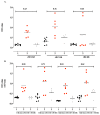Development of a promising antigenic cocktail for the global detection of Babesia caballi in horse by ELISA
- PMID: 37058508
- PMCID: PMC10104287
- DOI: 10.1371/journal.pone.0284535
Development of a promising antigenic cocktail for the global detection of Babesia caballi in horse by ELISA
Abstract
In this study, we designed novel truncated Babesia caballi (B. caballi) recombinant proteins from the previously used B. caballi proteins; 134-Kilodalton Protein (rBC134) and Merozoite Rhoptry 48 Protein (rBC48). Then, we evaluated the diagnostic performance of the newly designed proteins when used as a single antigen or when used as cocktail antigen consists of rBC134 full length (rBC134f) + newly designed rBC48 (rBC48t) or newly designed rBC134 (rBC134t) + rBC48t for the detection of B. caballi infection in horse using indirect enzyme-linked immunosorbent assay (iELISA). We used one dose and a half of each antigen in the cocktail formulas. The serum samples were collected from different endemic areas in addition to the sera collected from horses experimentally infected with B. caballi were used in the present study. Cocktail antigen in full dose of (rBC134f + rBC48t) exhibited the highest optical density (OD) values with B. caballi-infected sera and showed the lowest OD values with normal equine sera or B. caballi, and Theileria equi mixed infected sera in comparison with the single antigen. Interestingly, the same cocktail antigen exhibited the highest concordance rate (76.74%) and kappa value (0.79) in the screening of 200 field serum samples collected from five B. caballi endemic countries, including South Africa (n = 40), Ghana (n = 40), Mongolia (n = 40), Thailand (n = 40), and China (n = 40) using iELISA and the results were compared to those of indirect fluorescent antibody test (IFAT) as a reference. Moreover, the identified promising cocktail full dose antigen (rBC134f + rBC48t) showed that it can detect the infection as early as the 4th day post-infection in sera collected from experimentally infected horses. The obtained results revealed the reliability of the rBC134f + rBC48t cocktail antigen when used in full dose for the detection of specific antibodies to B. caballi in horses which will be useful for epidemiological surveys and control of equine babesiosis.
Copyright: © 2023 El-Sayed et al. This is an open access article distributed under the terms of the Creative Commons Attribution License, which permits unrestricted use, distribution, and reproduction in any medium, provided the original author and source are credited.
Conflict of interest statement
The authors have declared that no competing interests exist.
Figures


Similar articles
-
A Seroepidemiological Survey of Theileria equi and Babesia caballi in Horses in Mongolia.J Parasitol. 2019 Aug;105(4):580-586. J Parasitol. 2019. PMID: 31414947
-
Diagnosis of Babesia caballi and Theileria equi infections in horses in Sudan using ELISA and PCR.Parasitol Res. 2008 Oct;103(5):1145-50. doi: 10.1007/s00436-008-1108-z. Epub 2008 Jul 10. Parasitol Res. 2008. PMID: 18618143
-
Molecular and serological detection of Theileria equi and Babesia caballi infection in horses and ixodid ticks in Iran.Ticks Tick Borne Dis. 2014 Apr;5(3):239-44. doi: 10.1016/j.ttbdis.2013.11.008. Epub 2014 Feb 17. Ticks Tick Borne Dis. 2014. PMID: 24556274
-
Development and validation of a duplex real-time PCR assay for the diagnosis of equine piroplasmosis.Parasit Vectors. 2018 Mar 2;11(1):125. doi: 10.1186/s13071-018-2751-6. Parasit Vectors. 2018. PMID: 29499748 Free PMC article.
-
Development of a Test Card Based on Colloidal Gold Immunochromatographic Strips for Rapid Detection of Antibodies against Theileria equi and Babesia caballi.Microbiol Spectr. 2022 Feb 23;10(1):e0241121. doi: 10.1128/spectrum.02411-21. Epub 2022 Feb 23. Microbiol Spectr. 2022. PMID: 35196786 Free PMC article.
Cited by
-
Investigation of Babesia spp. and Theileria spp. in ticks from Western China and identification of a novel genotype of Babesia caballi.BMC Vet Res. 2024 Jul 8;20(1):302. doi: 10.1186/s12917-024-04171-z. BMC Vet Res. 2024. PMID: 38978113 Free PMC article.
-
New insights in the diagnosis and treatment of equine piroplasmosis: pitfalls, idiosyncrasies, and myths.Front Vet Sci. 2024 Aug 14;11:1459989. doi: 10.3389/fvets.2024.1459989. eCollection 2024. Front Vet Sci. 2024. PMID: 39205808 Free PMC article. Review.
-
Research progress on diagnostic techniques for different Babesia species in persistent infections.Front Cell Infect Microbiol. 2025 May 16;15:1575227. doi: 10.3389/fcimb.2025.1575227. eCollection 2025. Front Cell Infect Microbiol. 2025. PMID: 40453708 Free PMC article. Review.
References
-
- Onyiche TE, Suganuma K, Igarashi I, Yokoyama N, Xuan X, Thekisoe O. A Review on Equine Piroplasmosis: Epidemiology, Vector Ecology, Risk Factors, Host Immunity, Diagnosis and Control. Int J Environ Res Public Health. 2019;16(10). Epub 2019/05/19. doi: 10.3390/ijerph16101736 ; PubMed Central PMCID: PMC6572709. - DOI - PMC - PubMed
Publication types
MeSH terms
LinkOut - more resources
Full Text Sources

